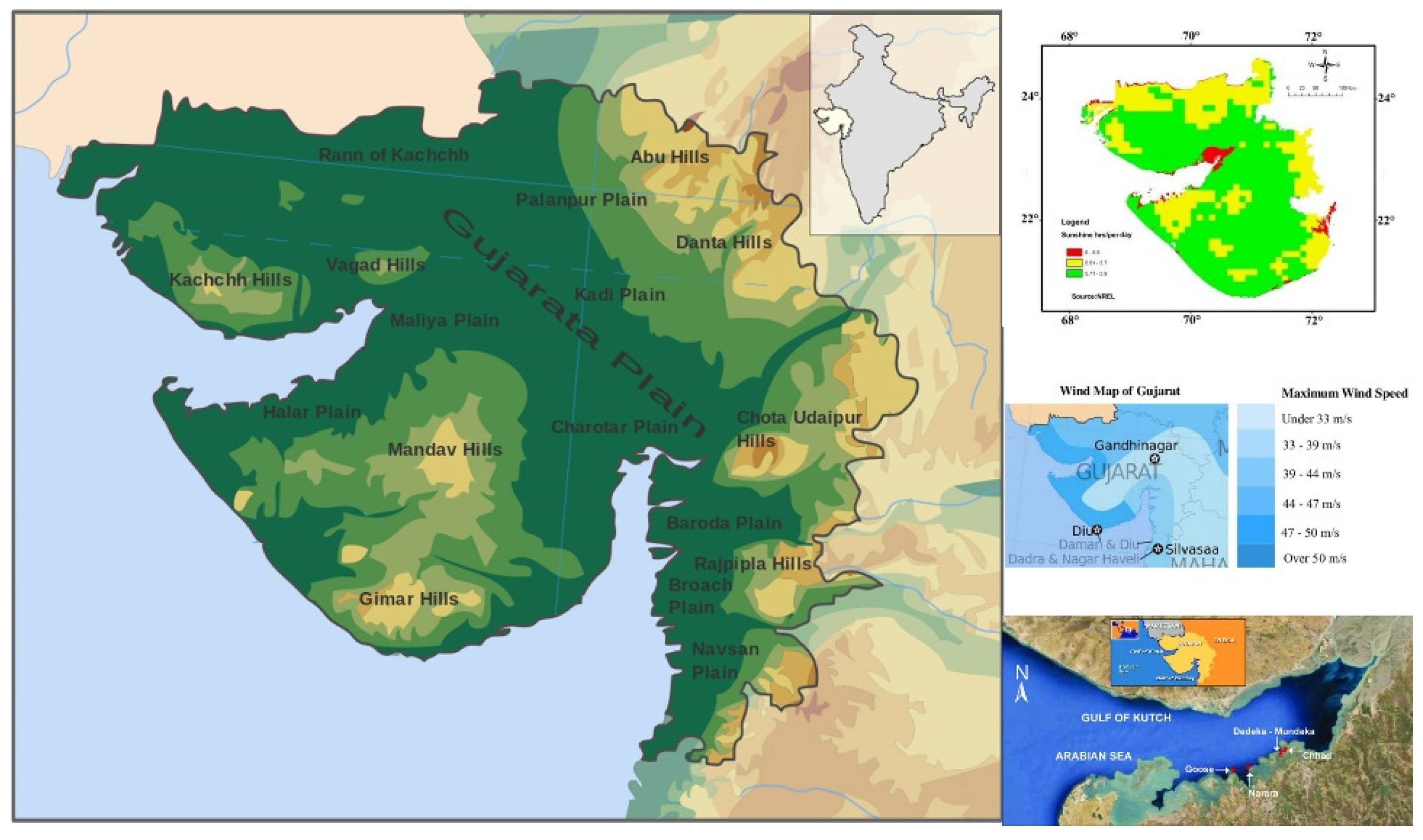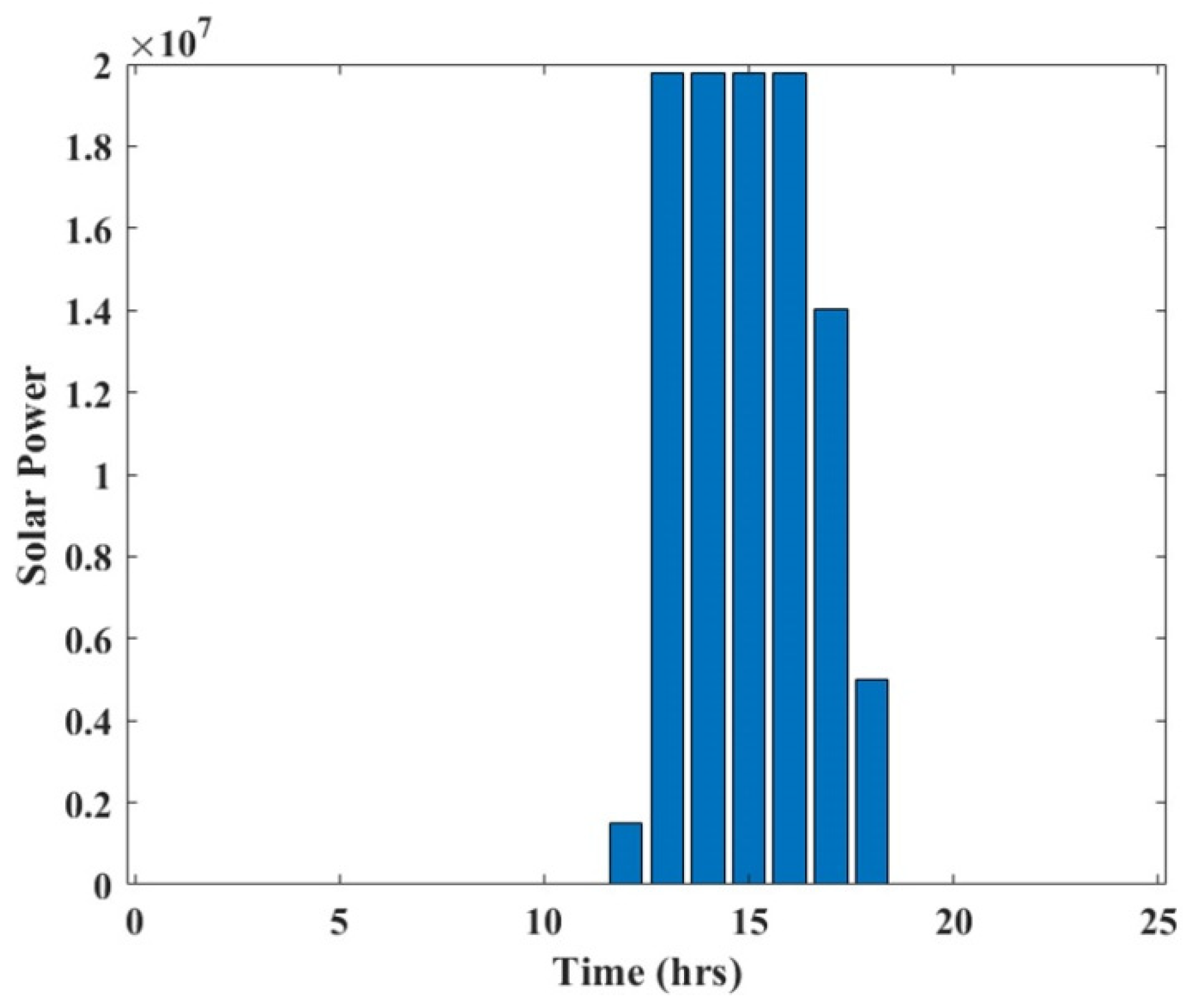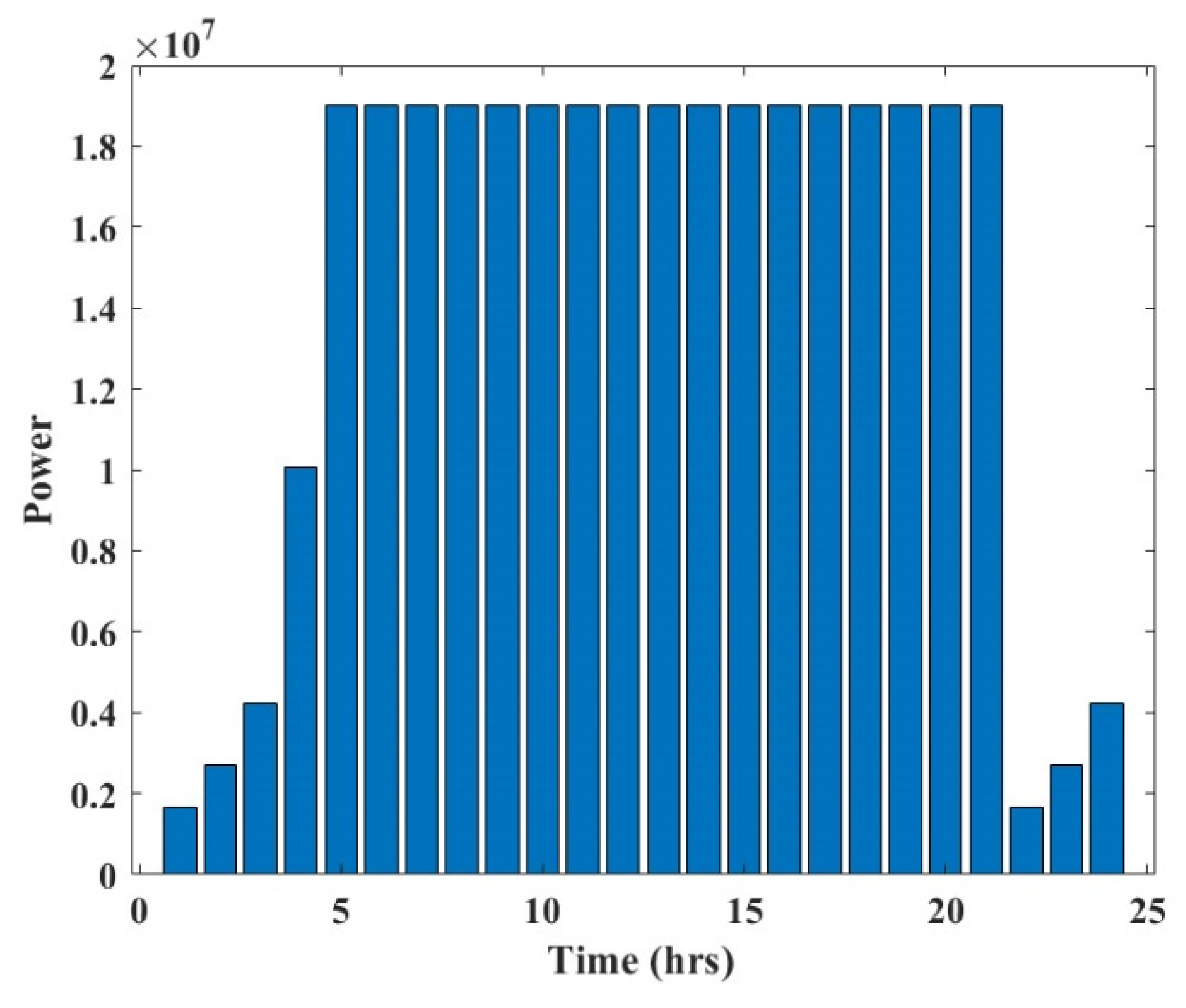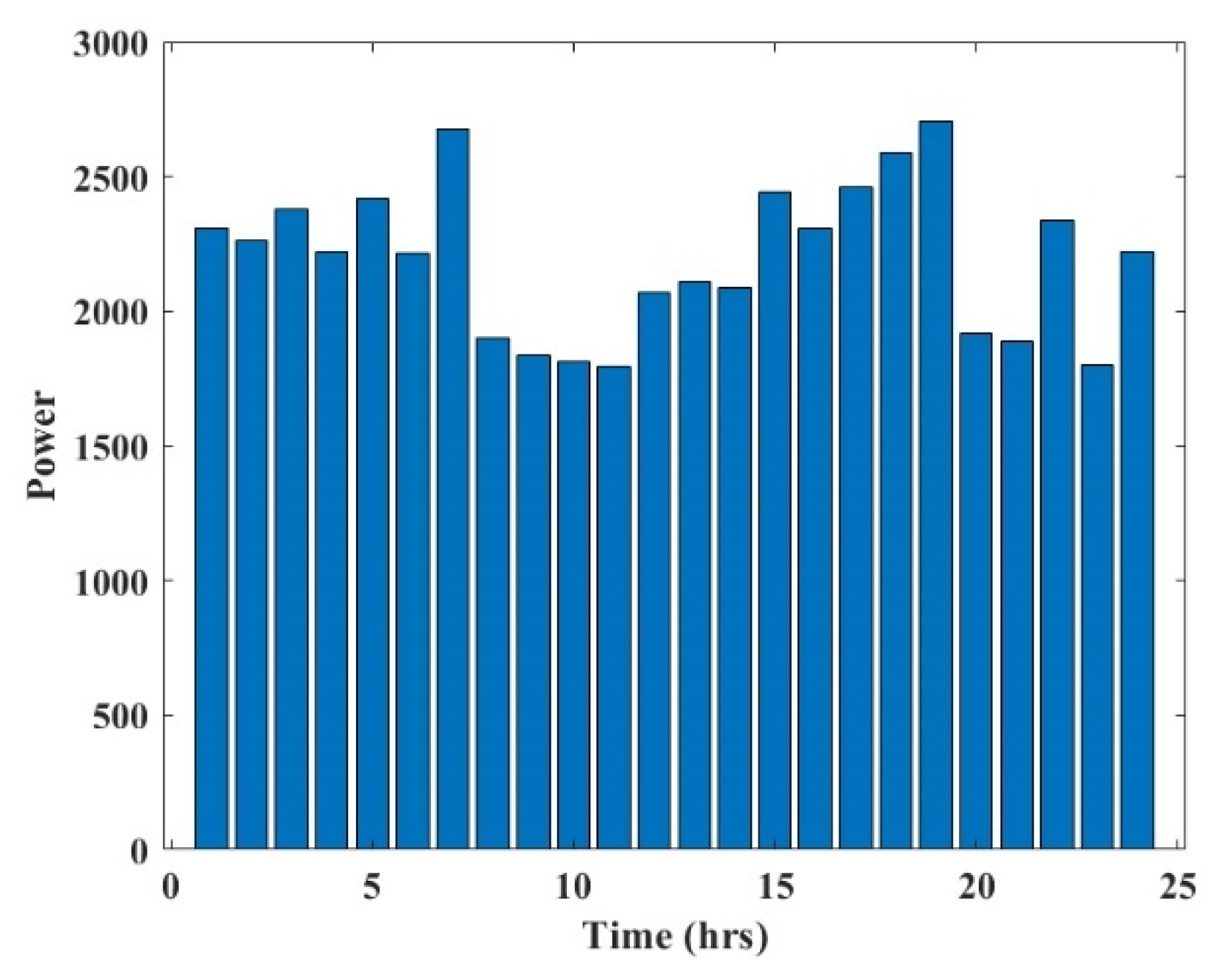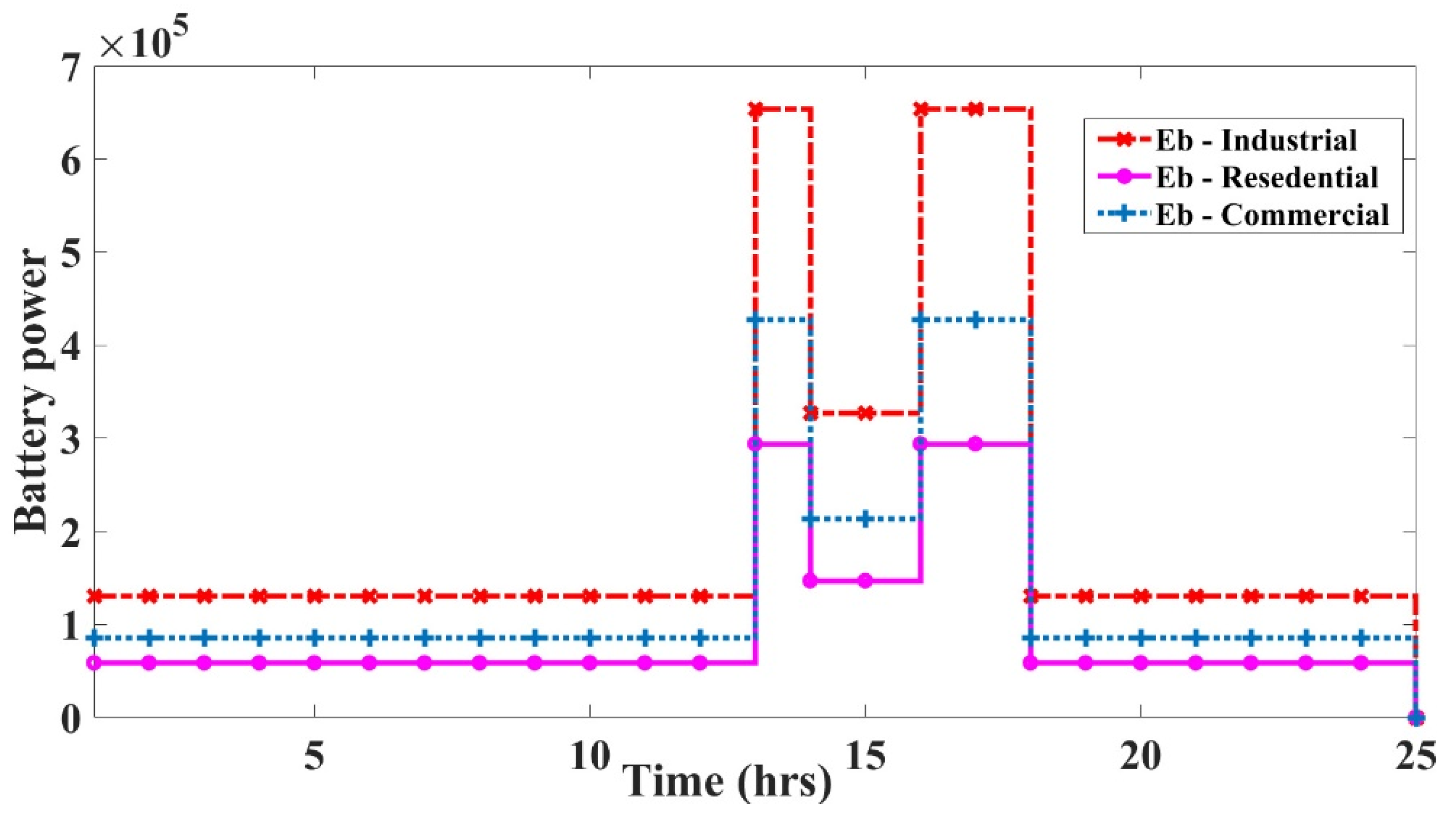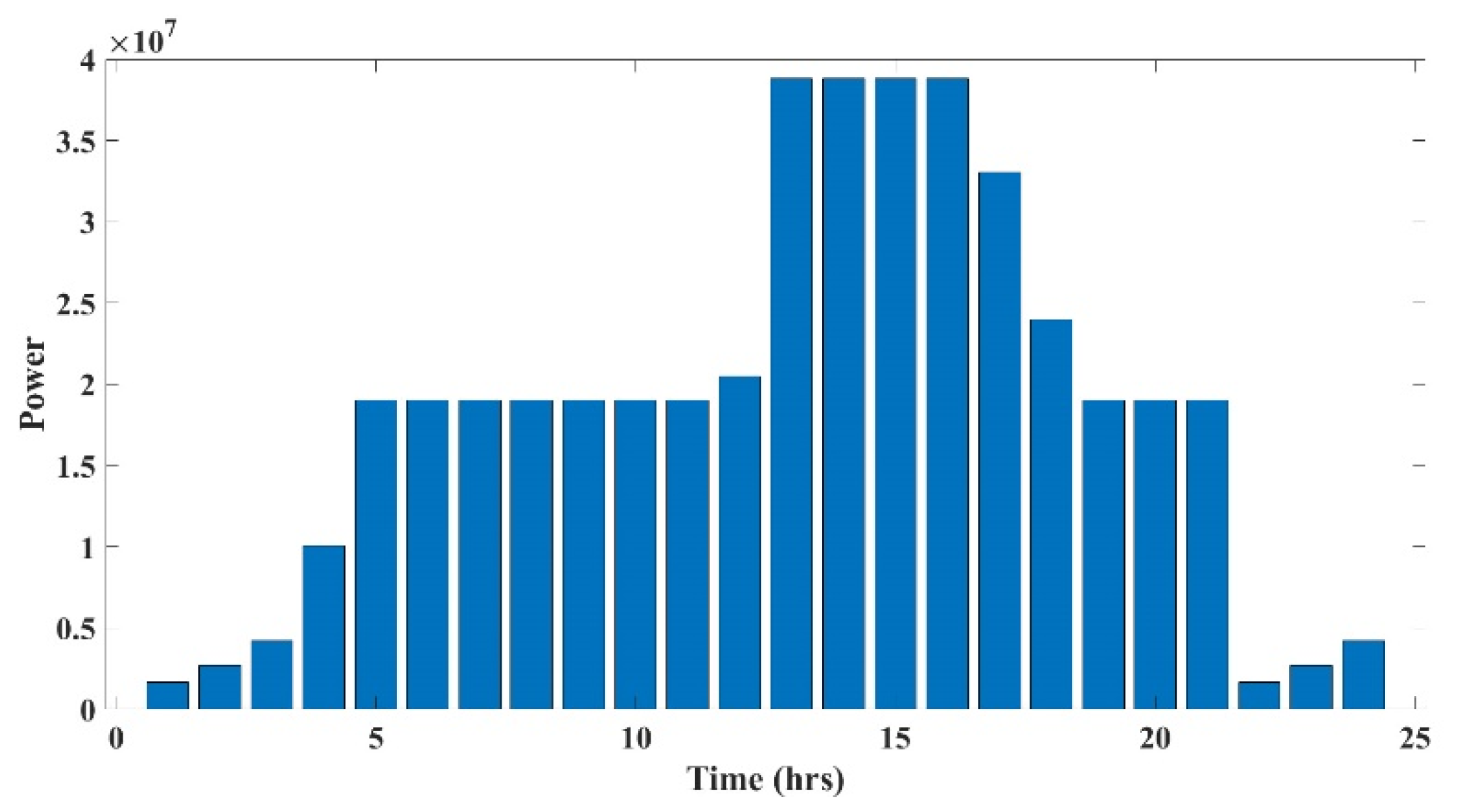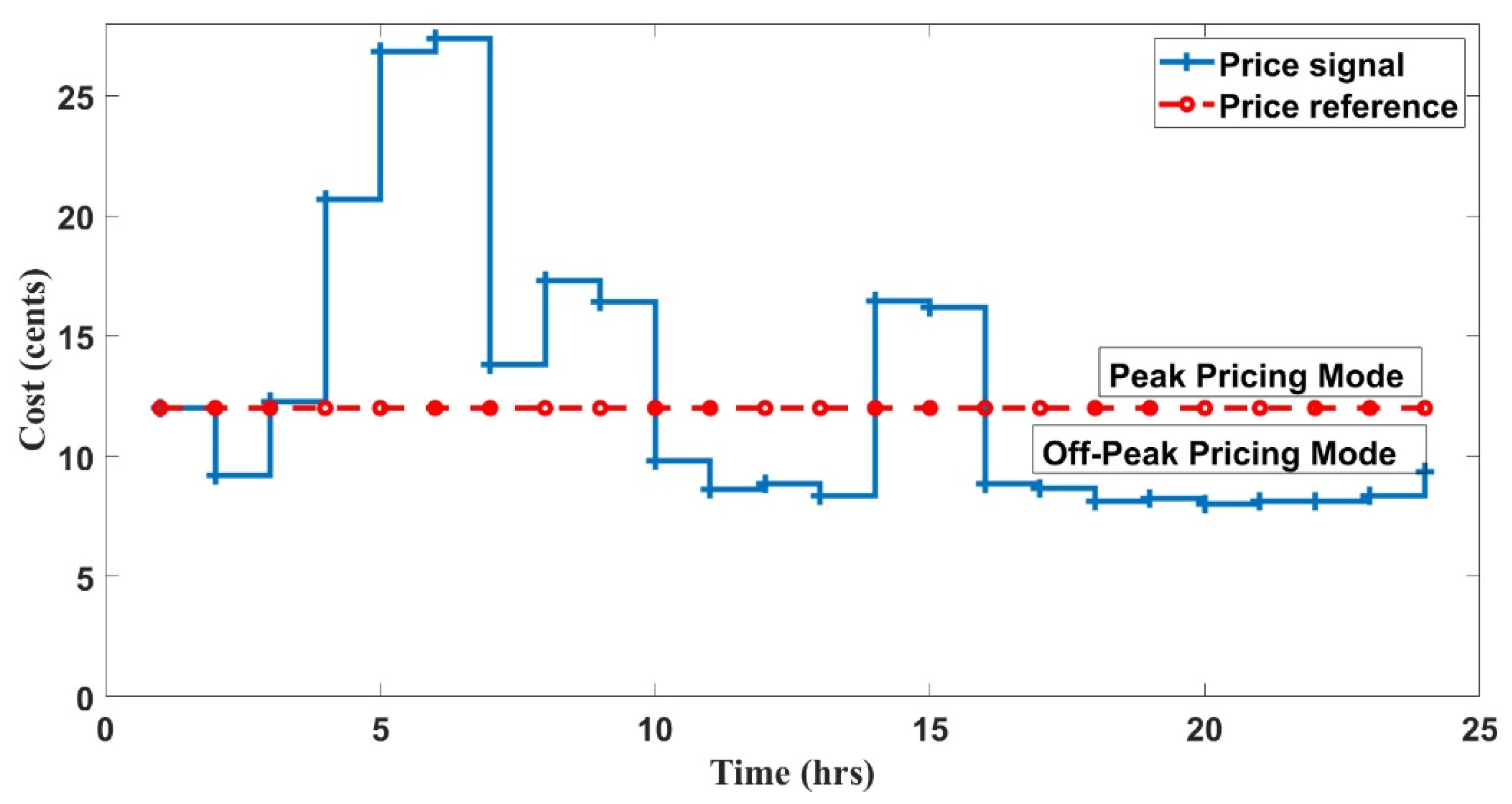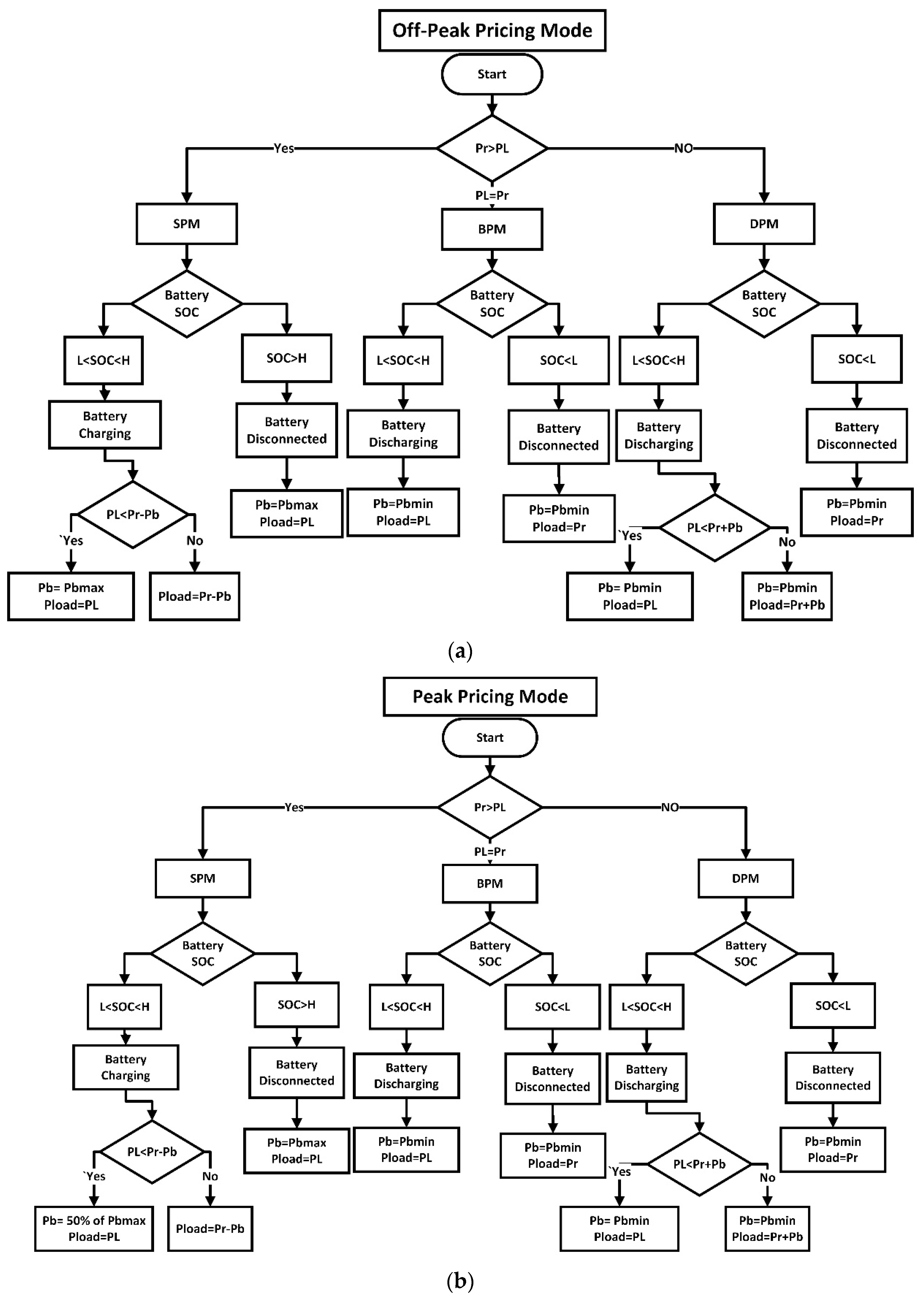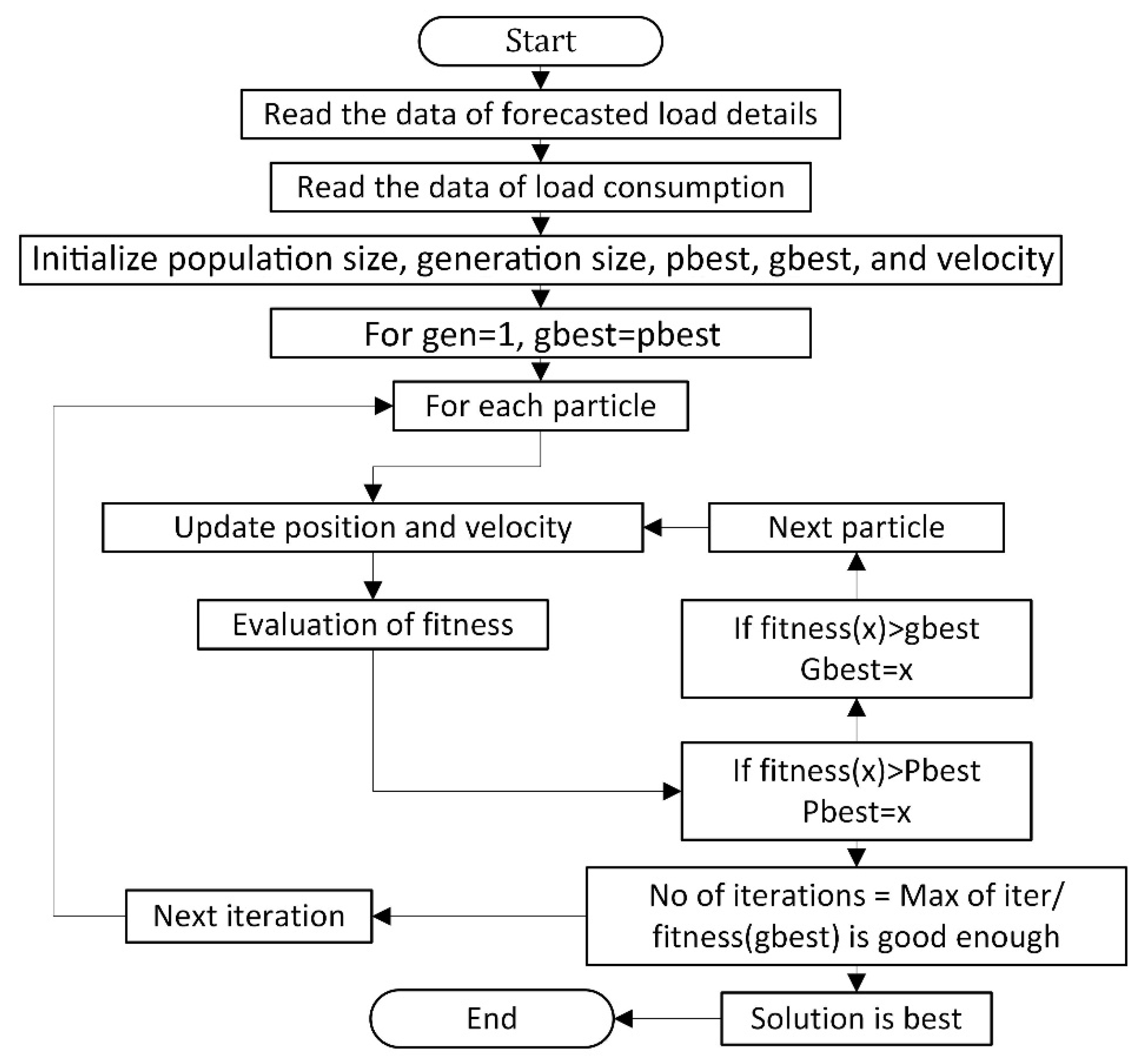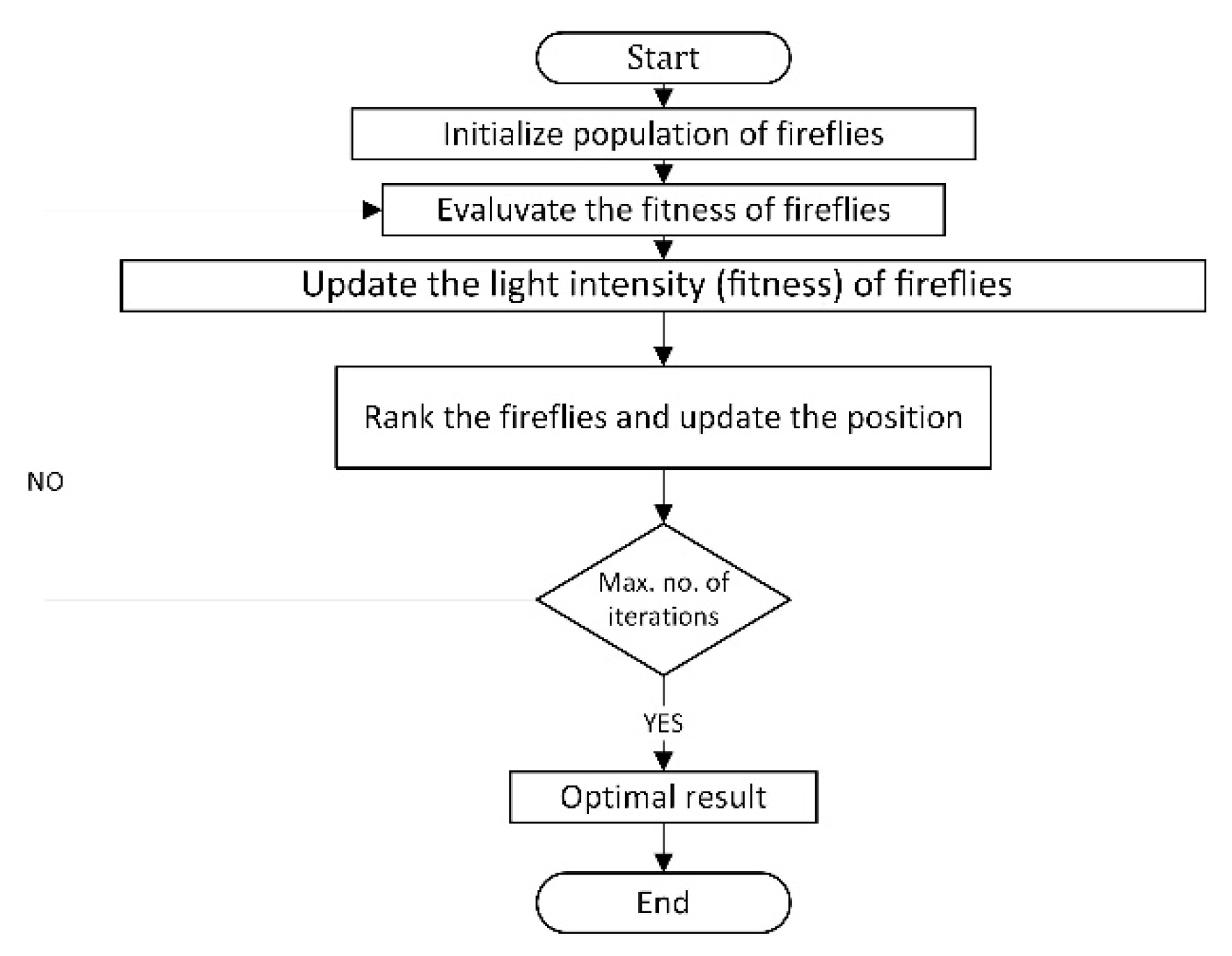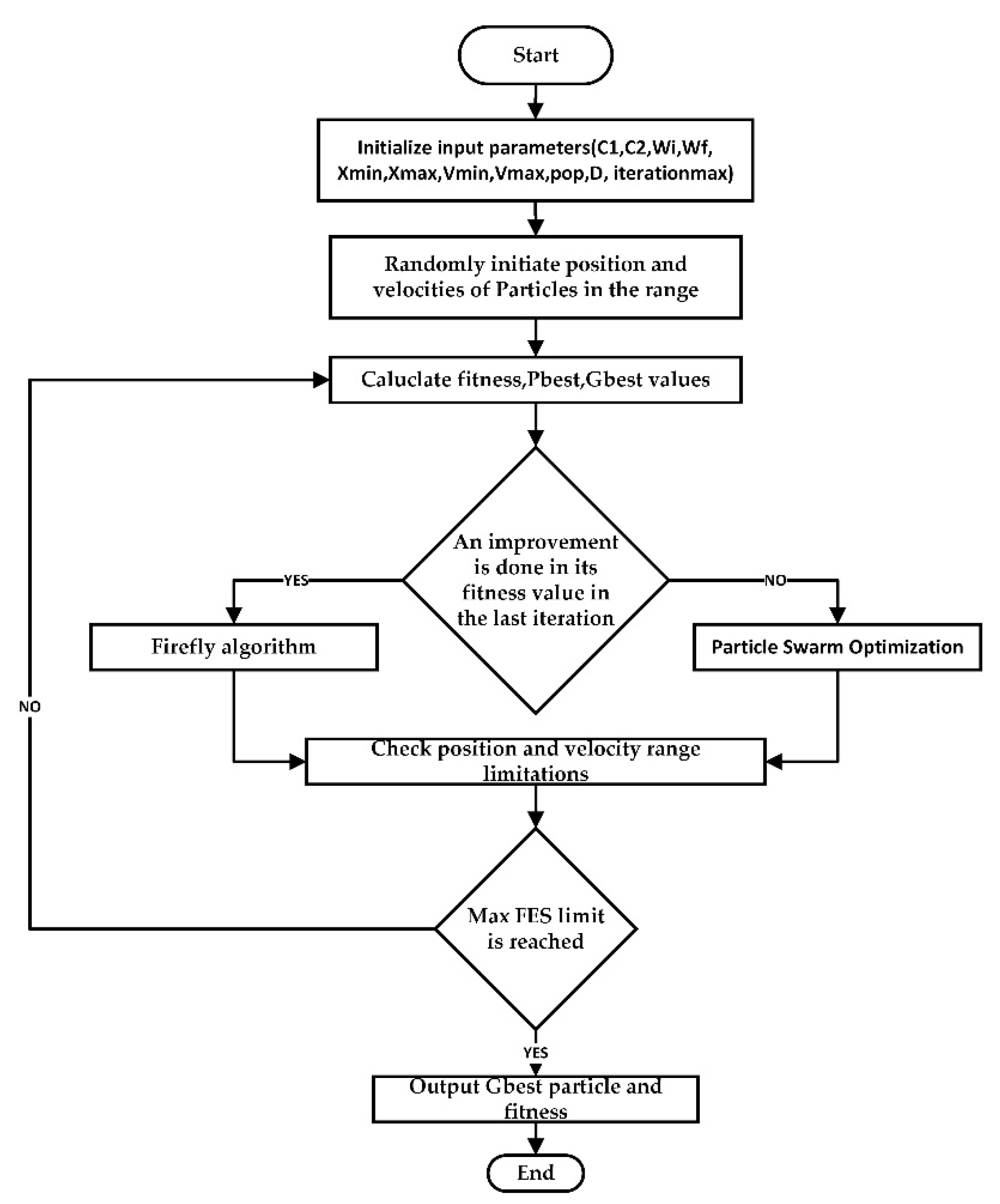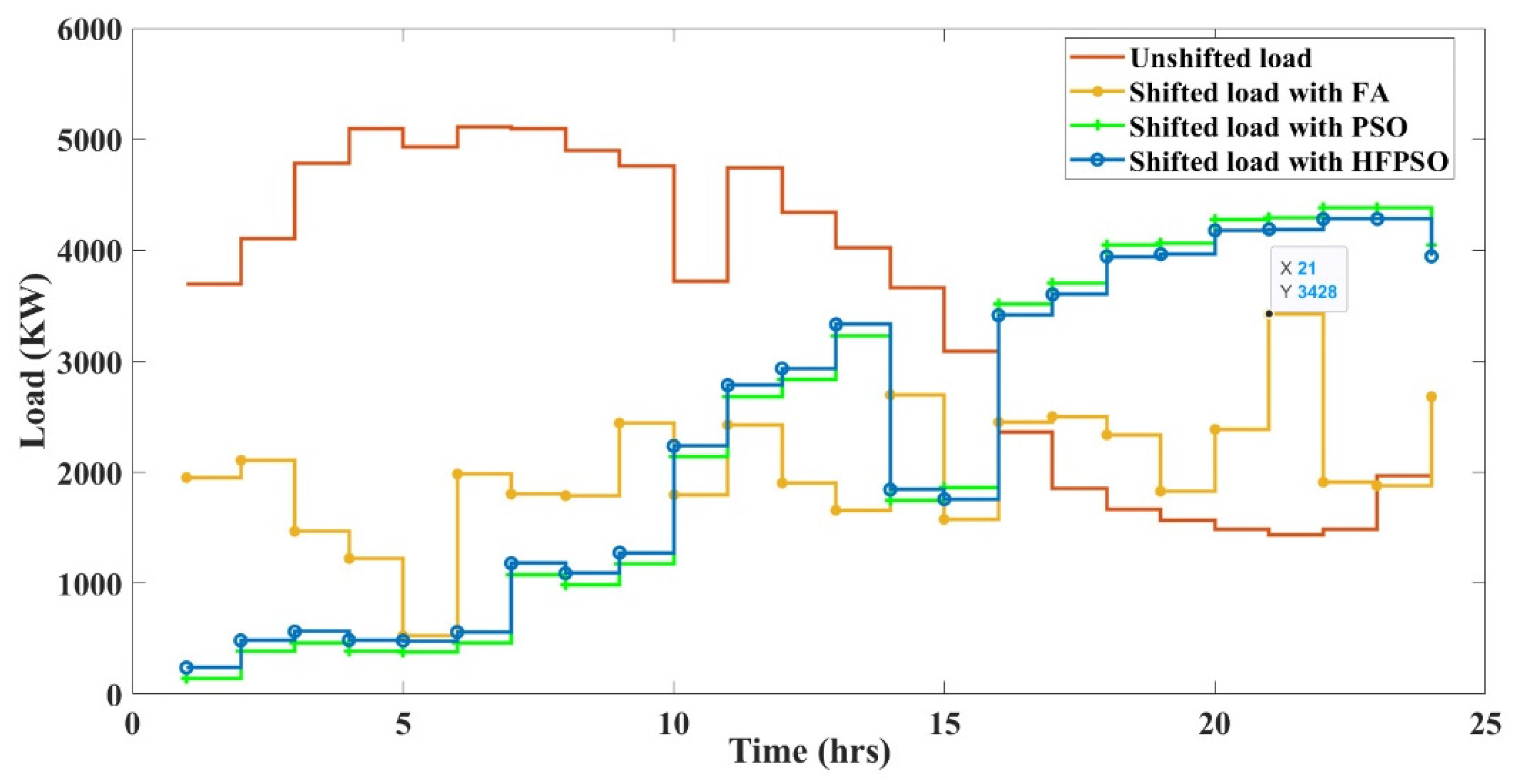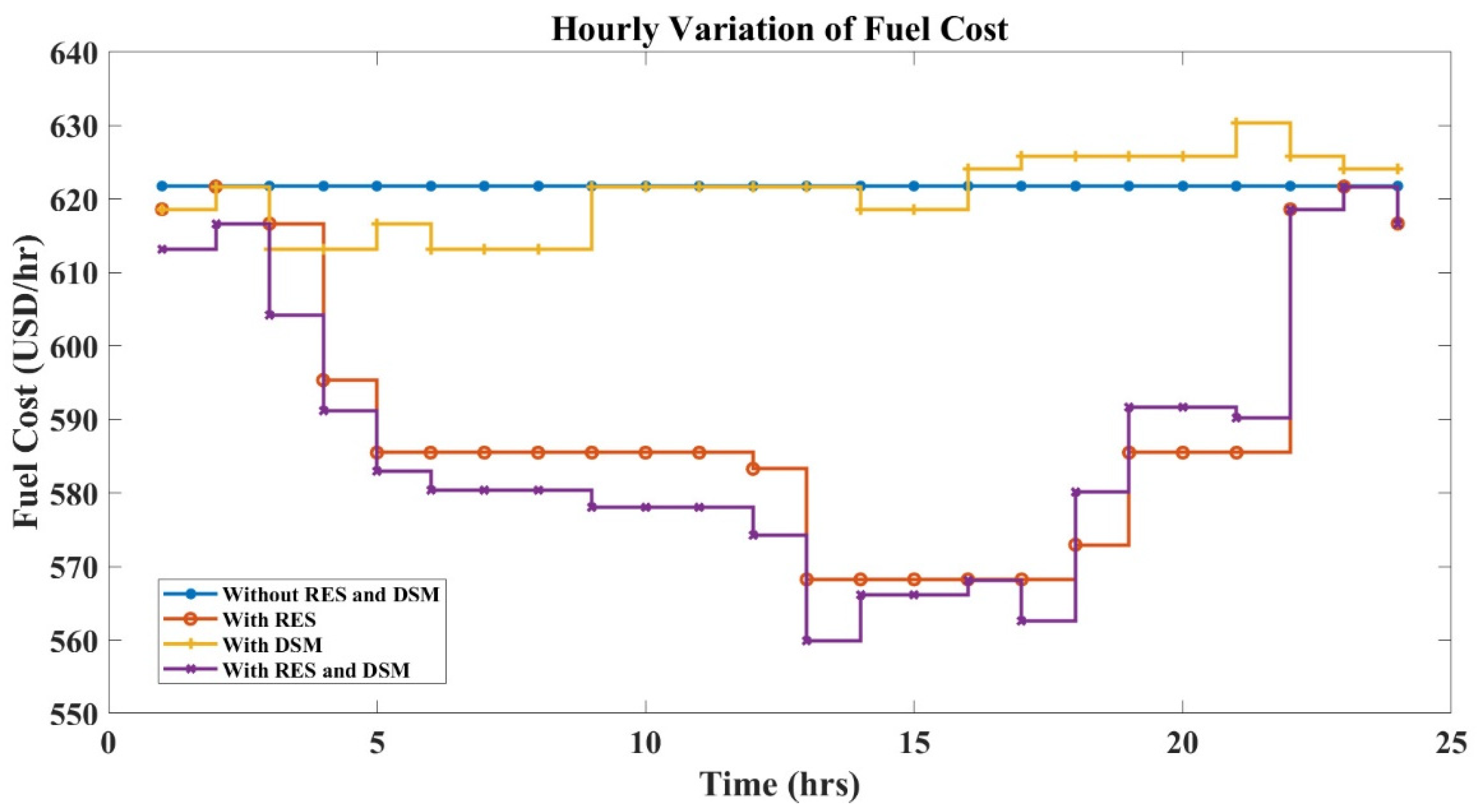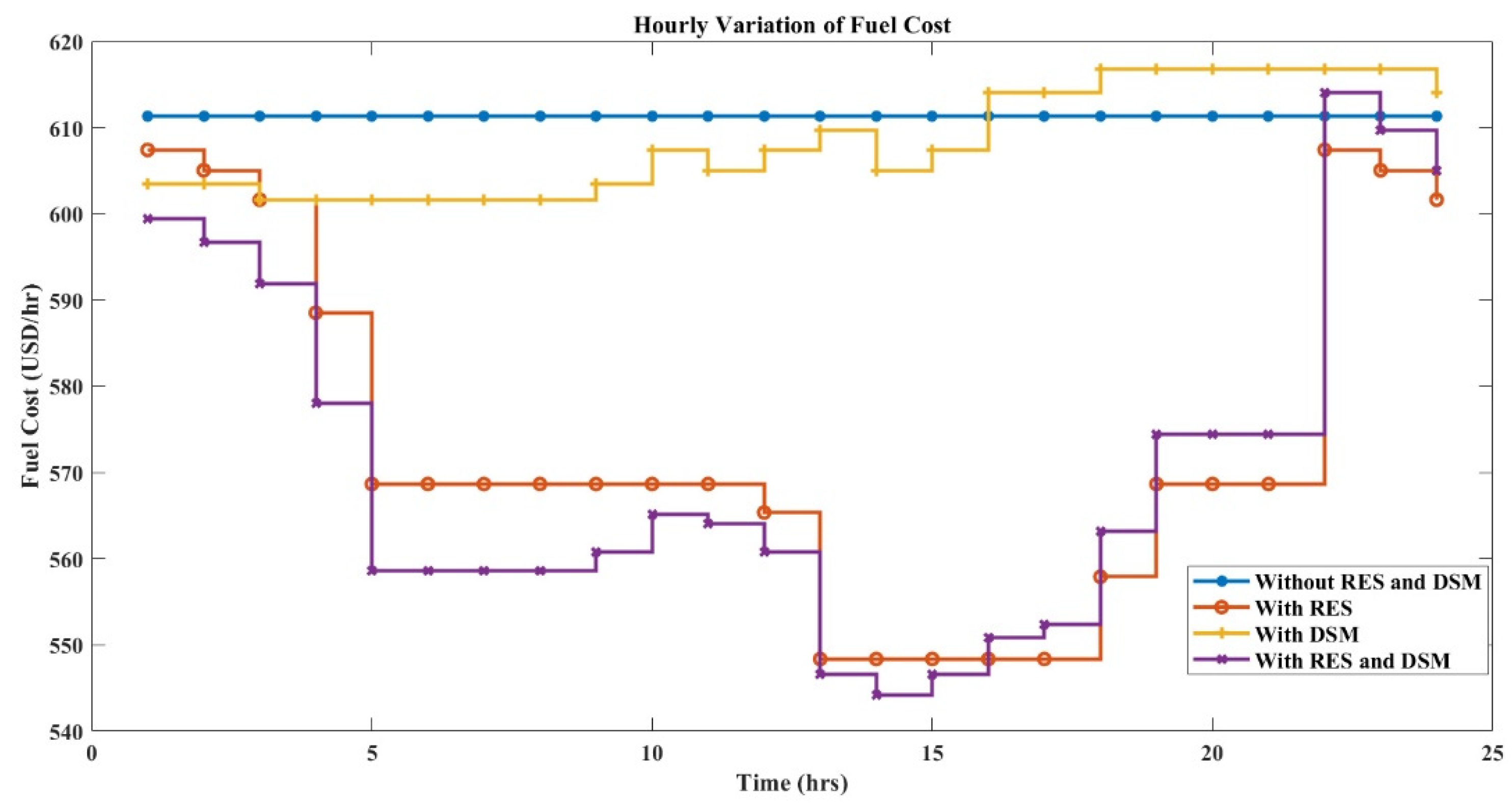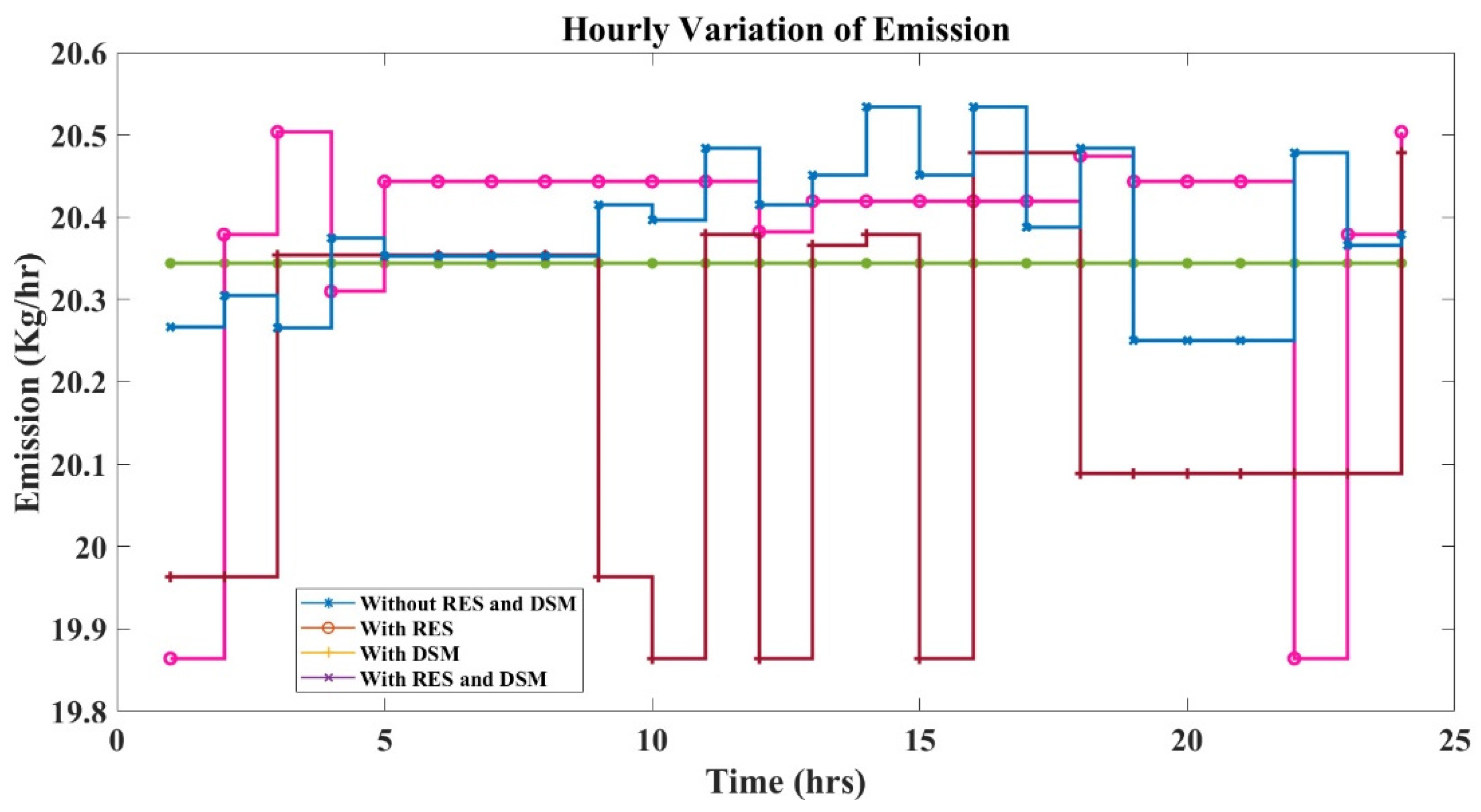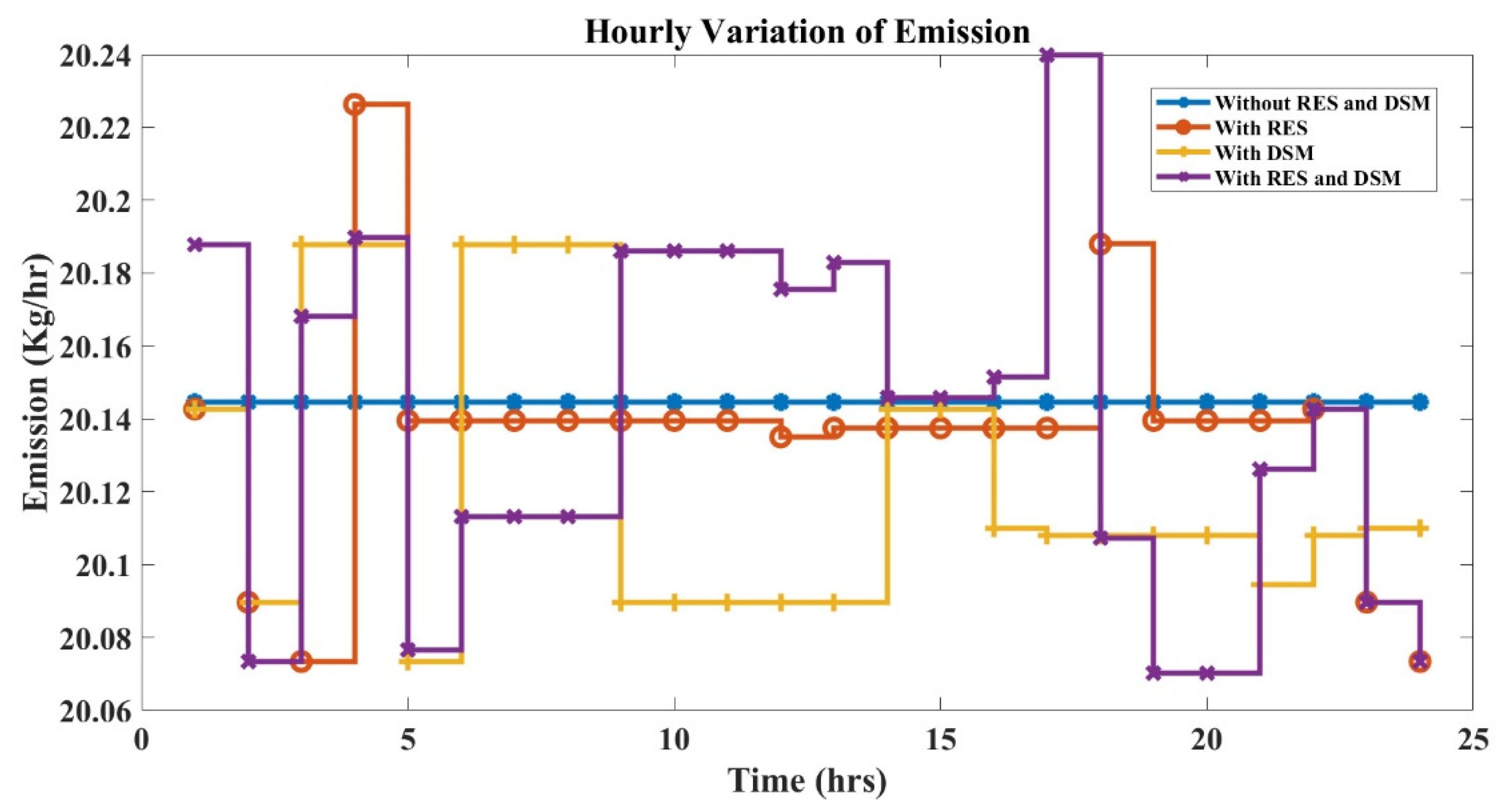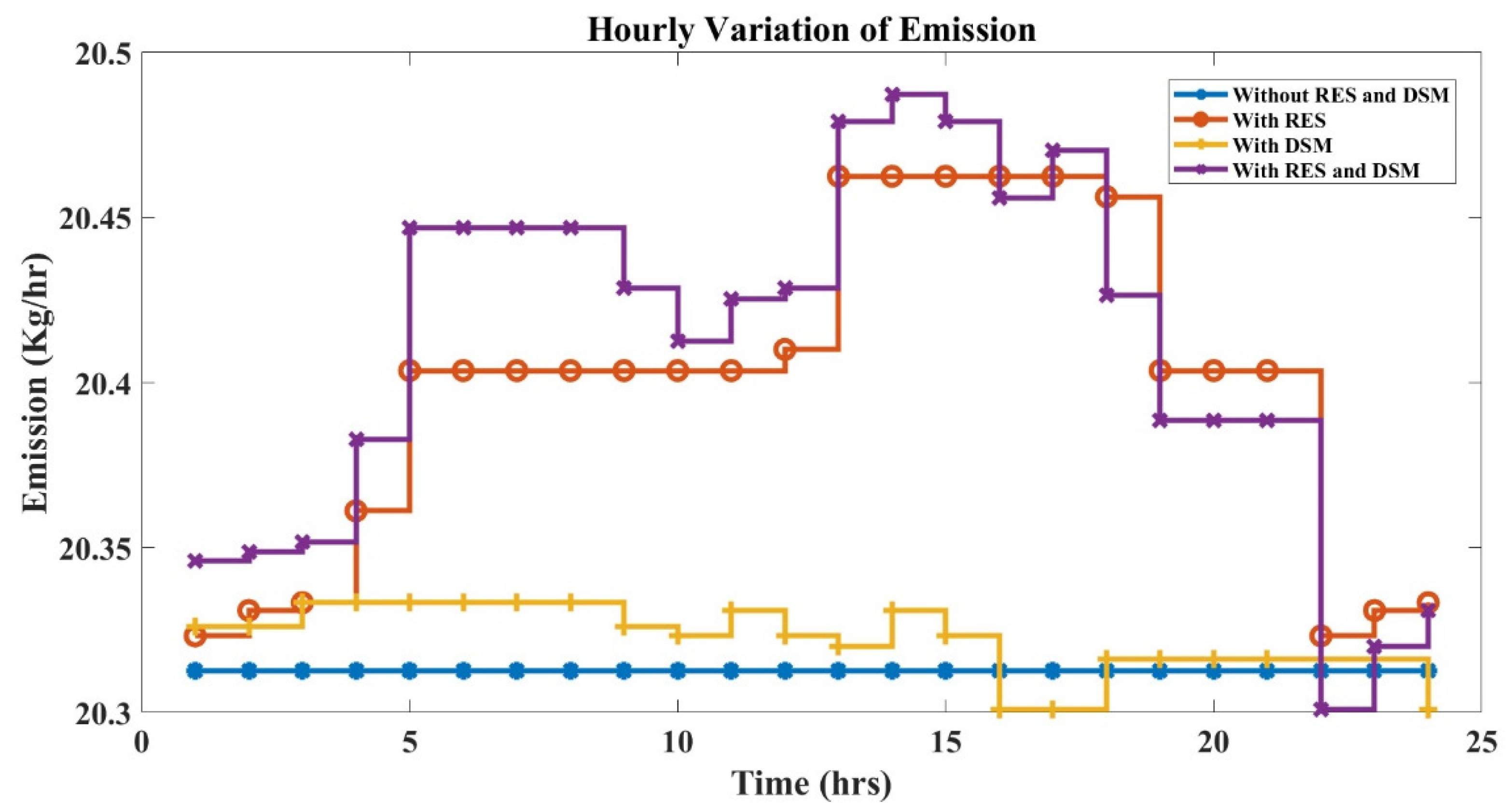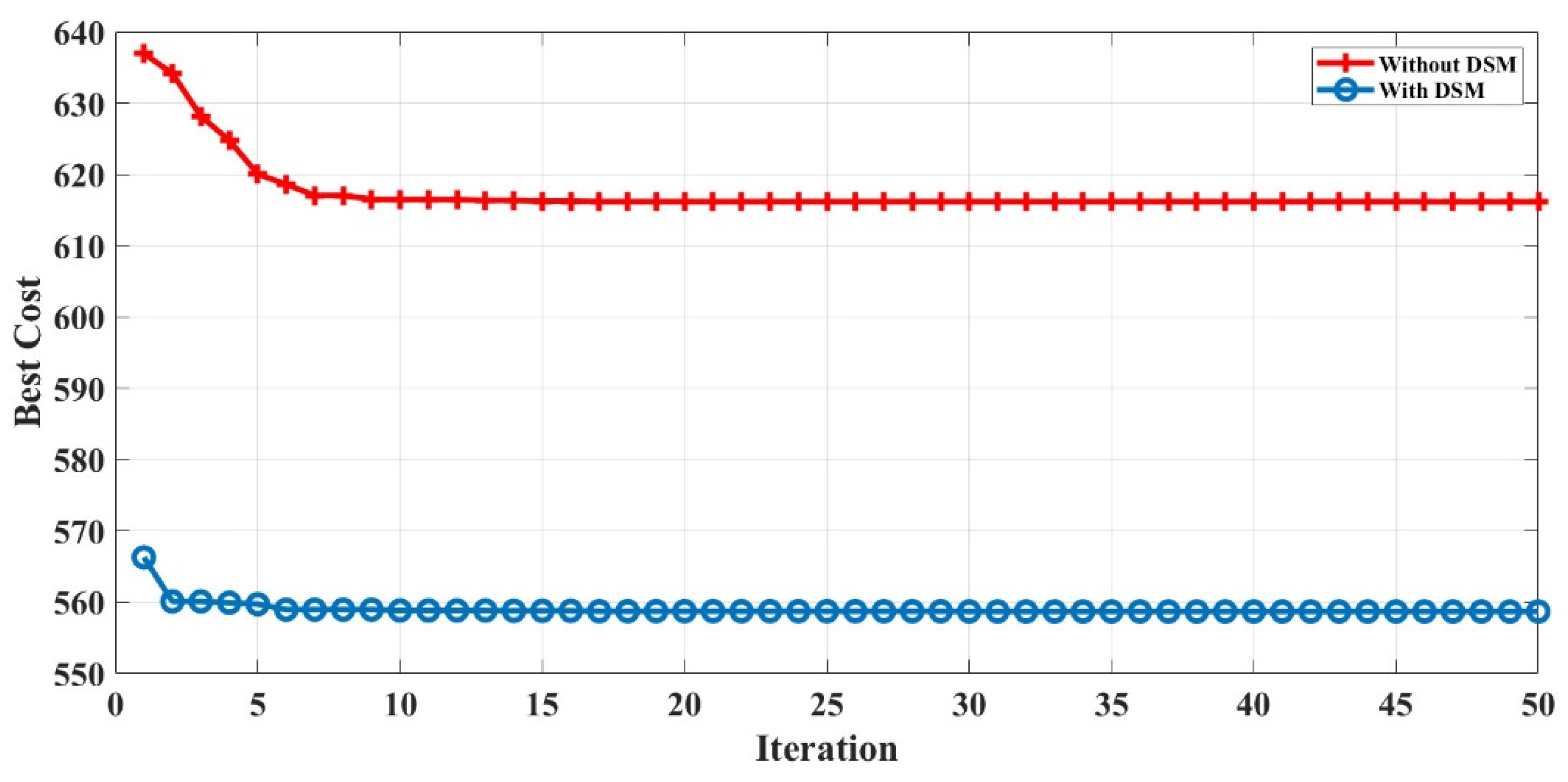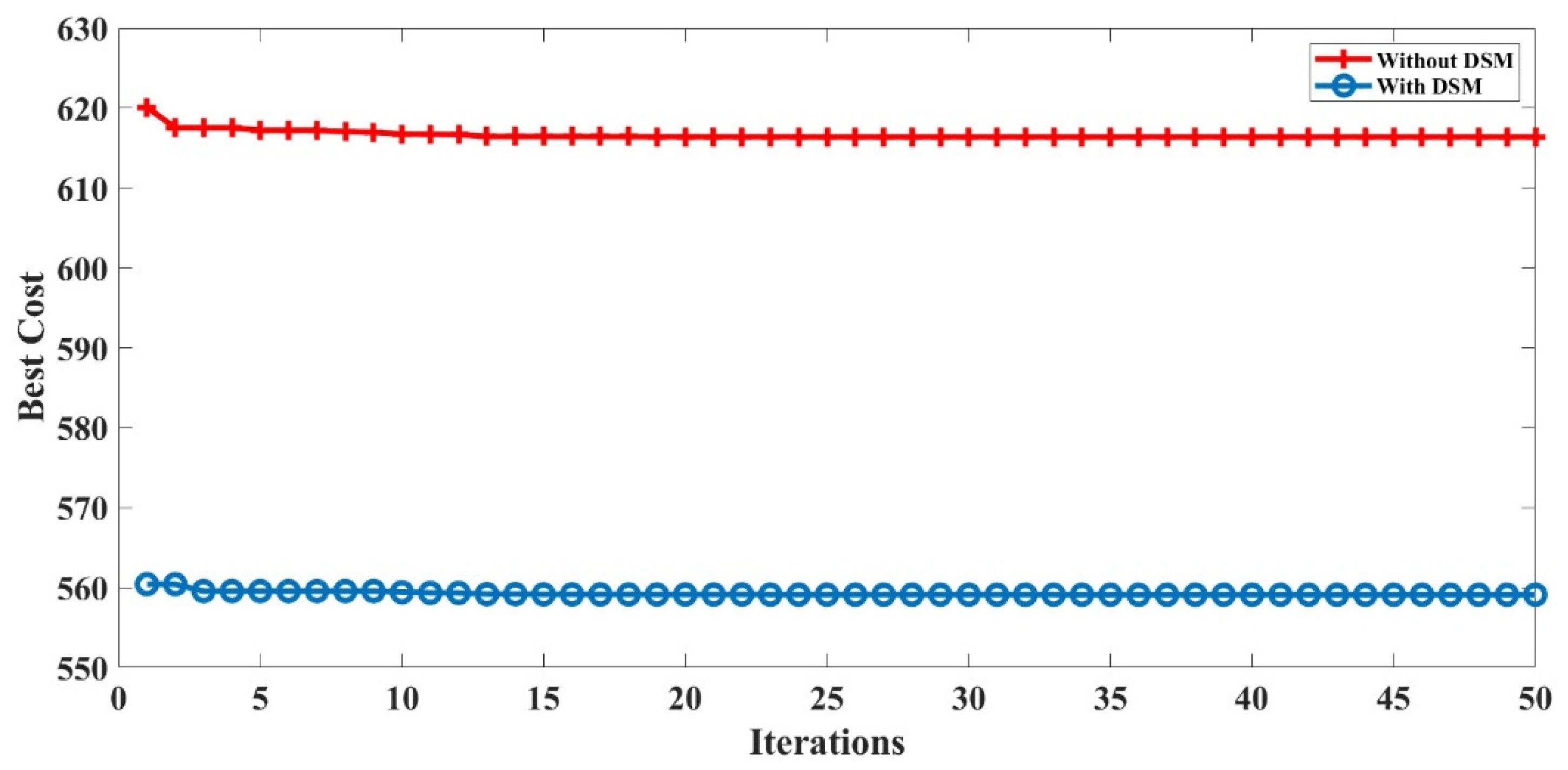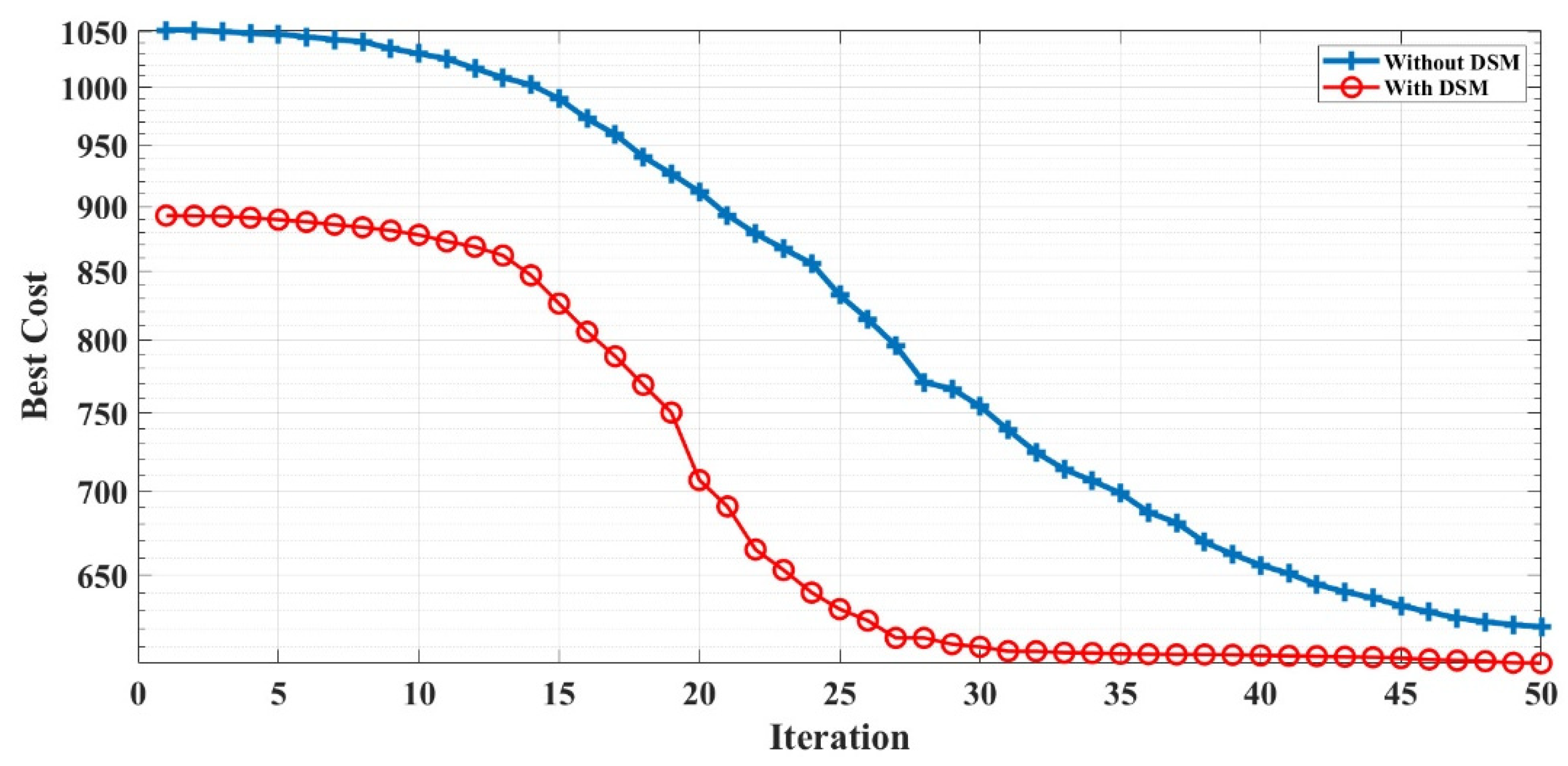1. Introduction
The primary goal of modern electrical utilities is to provide customers with a high-quality electricity supply at the lowest possible cost while taking care of the environment. Combined economic and emission load dispatch (ELD) is the basic process of matching the load demand by allocating to the available generating units. Its operation involves minimum generation cost and carbon emission maintaining other constraints of the power systems. Due to the country’s changing climatic conditions, the emission of toxic gases such as NOx, COx, and SOx from thermal generating units has become the primary concern. Concentrating only on minimizing the generation cost may increase the emission and vice versa. Therefore, the economic emission dispatch (EED) idea fulfills the minimum expense and minimum pollution criteria.
This growing concern of CO
2 emissions and global warming motivates the world to be more vigilant in meeting its energy needs with renewable energy sources [
1,
2]. India intends to reduce its gross domestic product (GDP)-related emissions by 33–35% by 2030 compared to 2005 and generate 40% of its total electric power capacity of around 350 GW using renewable energy sources [
3]. While mapping solar energy hot spots, the Indian Space Research Organization (ISRO) discovered that Gujarat receives the most solar radiation, making it the best place to develop a solar power plant. India has 7517 km of coastline in terms of wind energy, with territorial waters extending out to 12 nautical miles. Renewable energy sources make up 12.2% of India’s generation capacity, with wind energy contributing to 70% of that (International Renewable Energy Agency, 2020). In 1986, Gujarat became the first Indian state to establish a wind energy project (Centre for Wind Energy Technology (CWET), 2020). At 80 m, the wind power is expected to be 102,778 MW, and at 50 m, it will be 49,130 MW. At the same time, Gujarat has the country’s second-largest installed wind power generation capacity. The area along the west coast of India, stretching in the north-eastern part of the Arabian Sea, between 68°20′–70°40′ E and 22°15′–23°40′ N, covering an area of 7300 km
2 (
Figure 1) located in Gujarat, was considered for the study. It stretches 180 km east-west, with 70 km at the mouth to 1 to 2 km at the creeks in the east. The Gulf’s depth ranges from 60 m at the mouth to 20 m at the eastern end. Kandla, Mandvi, Mundra, Navlakhi, and Okha are major ports in the Gulf. Except for the Indus River, which is 100 km northwest of the Gulf’s mouth, the Gulf has no rivers, tributaries, or other freshwater outlets.
This work began in the wake of different research papers identified with DSM and power management strategies. Moving the energy utilization slot from peak price mode to off-peak price mode slot is the significant focus of the DSM and power management strategy so as to limit the service bill and fulfill the clients’ needs without bargaining their usage time of electrical appliances [
4,
5,
6]. The application of different optimization techniques in solving such problems is also an important research topic. The particle swarm optimization (PSO) algorithm is a popular nature-inspired swarm intelligence approach influenced by the way birds and fish live or chase life. This is commonly used in complicated and dynamic modeling topics. Established strong PSO capabilities are simple to incorporate, with fewer power processing demands and rapid convergence. It also has certain drawbacks, such as local optimization trapping and a sluggish convergence rate in exploitation [
7,
8]. The firefly algorithm (FA) is reported to have a few benefits over the PSO [
9] algorithm. For instance, the FA may not have the best individual or other global best, which avoids trapped premature convergence or local minima drawbacks. Interestingly, the velocity characteristic is absent in the FA [
10]. While the FA has a solid neighborhood search, it is frequently struck at a local minimum as it cannot stay away from local search altogether [
11]. The combination of these two algorithms, the so-called hybrid firefly particle swarm optimization (HFPSO), is found to provide increasingly stable conduct and more prominent adaptability against confounded and troublesome issues [
12]. In HFPSO, the strong local search functionality of the FA and the rapid convergence capabilities of PSO are utilized in a combined fashion.
This paper provides an insight into the customer’s objective to reduce the utility bill by keeping an eye on environmental concerns. The novel application of the PMA in the study gives a glance at maintaining storage devices by maintaining appropriate RES generation apart from conventional thermal generation. A maiden attempt of using the HFPSO algorithm for the analysis of the EED problem gives a better solution to the generator scheduling.
The features of our work are as follows:
Along with thermal and battery energy storage, hybrid generation systems (solar thermal/wind/wave) were considered.
Three different zones of loads were considered: residential, commercial, and industrial.
A day-ahead pricing scheme was considered for implementing a power management strategy.
The power management algorithm was performed mainly in two categories: peak pricing and off-peak pricing modes.
To solve the power management problem, performance metrics fuel cost, electricity cost, peak-to-average ratio (PAR), and emission were investigated.
Application of the heuristic optimization technique, HFPSO, to solve the objectives.
The rest of the paper is organized as follows:
Section 2, literature review;
Section 3, illustrated problem formulation, brief study of CEED, RESs, DSM strategy, and PMA; in
Section 4, the meta-heuristic algorithms PSO, FA, and HFPSO are discussed; the results and main findings of the research work are discussed in
Section 5; and finally,
Section 6 concludes the work.
2. Literature Review
The comprehensive index of the EED problem concerning fuel cost and pollution emission can be improved by using PSO [
13,
14,
15]. When comparing results for various loads, it was found that PSO gives a better result than the differential evolution (DE) algorithm [
16]. The key advantage of PSO over other modern heuristics is simple to simulate secure and quick convergence, and less computing time than other heuristic methods. In DSM, utilizing energy-proficient electrical machines can likewise save, by and large, energy utilization. Load shifting, direct control, and time of use are three tools of DSM discussed in [
17,
18]. Additionally, 2.10 kg of CO
2 diminishes by utilizing energy-effective machine sets aside from 19.76% of the normal day-by-day energy utilization. In [
19], the impact of the innovations of the DSM program and metering speculations utilizing 78 American power utility panel data from 2009 to 2012 was assessed. Restriction of the number of power utilities is the main drawback of the paper. In [
20], the DSM issue was tackled utilizing a straightforward meta-heuristic. Three unique regions—residential (such as a dryer, dry washer, washing machine), commercial (such as water dispenser, oven, lights, air conditioner), and industrial (such as welding machine, induction motor, arc furnace, DC motor)—were considered. When contrasted, the outcomes show that cost decrement is higher in the industrial area than in the residential and commercial regions. A symbiotic organism search algorithm for taking care of the issue was utilized in [
21].
In [
22], the arrangement of a comparative issue in smart grid and writing computer programs was found for three distinct regions, viz. commercial, residential, and industrial users. Adil Imran et al. [
23] used the hybrid genetic particle swarm optimization (HGPO) algorithm to minimize the peak-to-average ratio (PAR), carbon emissions, and power bills and to maximize user comfort (UC) in residential buildings by a programmable energy management controller (HPEMC). Ghulam Hafeez et al. [
24] proposed an energy management technique to alleviate peak-to-average ratio (PAR), maximize user comfort (UC), and minimize the cost of electricity for IoT-enabled residential buildings using a price-based demand response (DR) program and the wind-driven bacterial foraging algorithm (WBFA). Hareesh Myneni et al. [
25] proposed an energy management strategy to coordinate the BESS system and single-stage grid-connected solar photovoltaic (SPV). Petalas et al. [
26] suggested a modified PSO (MPSO) algorithm that enhances the local search process in the particle swarm algorithm and tested it with several unrestricted, confined, minimax, and integer programming issues. The discoveries demonstrated the memetic answer for PSO. Wang et al. [
10], with a local quest for numerical optimization, recommended a new firefly algorithm (NFA). A firefly cannot launch the search process if the firefly is not brighter than the other firefly. The authors considered that the brighter fireflies will travel based on local search concepts in their suggested algorithm.
3. Problem Formulation
3.1. Cost of Operating Generators
The cost of fuel burning in coal plants adds to the dispatch process. The running costs of the generator include power, labor, and maintenance costs. Labor and repair expenses are not paid because they reflect a fixed portion of the incoming fuel prices. The active power production of the thermal power plant is measured in MW. In coal plants, the power output is improved by releasing the valves at the steam turbine inlet. When the valve is just raised, the losses are high, and when the valve is completely opened, the throttling losses are low. The cost curve of fuel is a quadratic equation of real power.
The fuel–cost curve as a function of active power takes the form [
14]
Here F is fuel cost (USD/h); ai, bi, and ci are the cost coefficients of the ith generator; and Pi is the active power output of the ith generator.
3.2. Pollutant Emission Function
The sum of a quadratic and an exponential function expresses the emission produced, and, thus, the emission objective function is defined by [
14]
where the emission coefficients of the ith generator are
αi,
βi,
γi,
ζi, and
λi.
Since the pollutant emitted is directly proportional to the fuel burnt, the emission function is similar to the fuel cost function. An extra exponential term is added due to atmospheric pollutants forming oxides of nitrogen, carbon, and sulfur.
3.3. System Constraints
3.3.1. Equality Constraints
Equality constraints are the simple balance of power equations assuming that total production equals total demand plus transmission losses [
14].
3.3.2. Inequality Constraints
Generator constraints: The generator’s kVA loading will not surpass the preset thermal limit. Thermal limitation constrains maximum actual power output, such that temperature increases remain under limits.
The inequality constraint states the range of the generator’s reactive power limits:
Network security constraints: In the case of an outage, whether planned or required, any of the network restrictions are not being followed. In the study of the large power grid, the complexity of the constraints is increased.
3.4. Demand-Side Management
The DSM assures a productive finding for the end-user as well as for the generating companies by optimally modifying load demand by balancing energy resources.
Load Leveling
Load leveling manages the load curve to avoid energy stockpiling from the generated power during high power demand.
The shapes of load leveling are as follows:
Load shifting;
Load growth;
Peak clipping;
Valley filling;
Flexible load;
Conservation.
Mathematical formulation: A snippet of data on the generation side given by the day-ahead demand-side management heretofore to gauge the necessary power demand in the impending days which will be provided to the customers.
The mathematical formulation for the load-shifting technique, Minimize:
where, at time
t, consumption (t) is unscheduled power consumption, and Objective (t) is scheduled power consumption. At time
t, consumption of load is given by
Connected and disconnected loads at time t are given by CON(t) and DCON(t).
where
D is the number of device types; j—for the device of type ‘
y’, total duration of consumption;
Xy
it—from time step
i to
y, the number of shifted devices of type
y;
P1y and (1 +
l)
y—for device type y, the power consumption at time step 1 and (1 +
l).
where
Xy
tq is the number of type
y devices, which are shifted from time step
t to
q, and the maximum allowable delay is
m.
The number of controllable devices of type
k at time
t is controllable (i).
3.5. Solar Thermal Energy System Modeling
This paper concentrates on CSPs in light of the fact that they obtain an expanding revenue, particularly whenever working with thermal energy storage. The CSPs can be sorted into three principle innovations, in light of the way toward gathering and thinking about sun-oriented radiation:
These exclude the fourth innovation (linear Fresnel reflector); however, it is less expected than the other three. The incident direct normal irradiation (DNI) will focus on a recipient tube of a parabolic trough collector, which is set at the focal line of trough-shaped mirrors. This paper concentrates on a CSP based on a parabolic trough (ETC150), dimensions of elements were mentioned in
Table 1. Biomass and natural gas were such fuels used in a CSP plant for hybridization to generate the rated gross power by taking care of transients that need to be given to the HTF.
Simulation of a solar field: Direct normal irradiation (DNI), cosθ and DNI × cosθ, and hourly average value data for a typical meteorological year (TMY) of Gujarat were considered from ISHRAE weather files.
The declination angle of the day (
δ) is given by
The angle of tilt of parabolic trough (
β) is given by
where
Φ is the latitude of the location, and from solar time, hour angle (
ω) can be calculated.
For a north-south aligned parabolic trough, the angle between the sun’s rays and normal to the mirror aperture (
θ) is given by
From the hourly values of
DNI ×
cosθ, the maximum value of
DNI ×
cosθ can be obtained. (
QI) is the solar power incident on the collector given by the equation
N is the product of the number of rows of the collector array, the number of modules in a collector, and the number of collectors in a row in the solar field.
(
Aa) is the actual aperture area given by
L—aperture length, W—aperture width, and Dco—outer diameter of absorber (receiver) cover.
The thermal power impinging on the absorber tube is given by
Ŋc—efficiency of solar collection; Ŋm—(ρ × γ); γ—intercept factor; and ρ—specular reflectivity.
Solar power input to the receiver tube per meter:
C is chord width. Thermal power given to the HTF:
ŋabs is the efficiency of the absorber tube. The thermal energy that can be stored is calculated from
The capacity of alternate fuel required for hybridization for thermal power is limited to 20% and given by
The electrical energy generated from the solar thermal power plant (
Figure 2) is given by
Pgd = Design rating of plant, Phtfd = Design rating of HTF.
3.6. Wind Energy System Modeling
In this work, a wind turbine with a blade diameter of 6.4 m, a swept area of 128.5 m2, and a rated output power of 5.5 kW was considered. The cut-in speed was 3 m/s, and the cut-out speed was 40 m/s to avoid damage at a hub height of 50 m. The efficiency was estimated to be 95% under standard test conditions. Oceans have the shortest surface roughness range, implying that wind speeds would be higher than on land; thus wind turbine power production is much more efficient.
As a renewable energy source, wind can be conceived that can be used to generate electricity. The Gulf of Kutch and the Gulf of Khambhat have the most wind resources, followed by Gujarat’s northwest and the peninsula’s southern tip with near-coastal winds of 6 to 7 m/s and overall sustained winds of 9 m/s. The calculated wind speed must be translated to desired hub heights at anemometer height because the wind speed varies with altitude. The following correlation is used to measure the power-law equation.
where, at hub height
h2, speed is
v2, at hub height
h1, speed is
v1, and α is the coefficient of friction. Wind speed, height above ground, terrain roughness, day of the week, year, and temperature are all factors that influence it.
Wind turbine’s power output (
Figure 3) can be estimated as
where Pr reflects rated power.
Vcutout,
Vrated, and
Vcutin are the cut-out wind speed, nominal wind speed, and cut-in wind speed, respectively. Since the
Vcutin is small, the small-scale wind turbines will operate efficiently even though the wind speed is not very high.
3.7. Wave Energy Converter Modeling
The mechanical and electrical conversion modes of wave energy converter (WEC) technologies differ widely, depending on the specific working theory. Point absorber technology is considered in this paper. These devices rely on resonance to get the most energy from the apparently periodic wave currents. An extracted power peak occurs in the 6–8 s wave duration when the incident wave frequency meets the device’s average resonant frequency. The frequency and persistence of wind speed are closely related to the energy profile of a wave, taking into account the size of the fetch field where the wind flows. In Gujarat, the Gulf of Kutch on the west coast has a maximum tidal range of 8 m and a current velocity of up to 3 m/s, making it one of the most appealing places in terms of energy. A variety of metrics are used to determine a WEC’s wave energy capacity and performance. The wave power density Pw, which is expressed in watts per square meter, is a popular way to display a site’s energy level. For a standard sine wave in profound water, the wave power per unit wavefront is given by:
Group velocity at which wave energy is carried:
The wavelength,
L, in terms of its period, is given by the equation:
The capture width ratio (CWR) is defined as the ratio of the power captured and the power in the width of the wave.
Power output per chamber:
where CWR = capture width ratio = 0.5, ρ = mass density of sea water = 1.025 kg/m
3, g = gravity acceleration = 9.8 m/s
2, d = water depth = 50 m, w = width of the opening of each OWC chamber = 4 m, Tk = the energy wave period(s), Hm0 = the significant wave height(m),
ŋt = total efficiency =
ŋp × ŋm × ŋe = 0.48, ŋp = efficiency of the conversion of a wave to pneumatic energy = 0.8, ŋm = efficiency of the conversion of pneumatic to mechanical energy, ŋe = efficiency of the conversion of mechanical to electrical energy, given that the actual power output per chamber (
Figure 4), Poc (kW):
Pr—power rating of the turbine generator group. Here we considered Pr as 10 kW and a total number of 10 turbine generator groups.
3.8. Battery Energy Storage System Modeling
The capacity of a battery storage system is determined by the total demand of the day. As three different types of load profiles were considered in the research, the capacity of the battery was calculated accordingly. The efficiency was estimated to be 95%; the battery’s round trip DC-storage-to-DC energetic efficiency and the state of charge (SOC) under which the battery must never be drawn were 85% and 30%, respectively. The system’s battery capacity (kW) (
Figure 5) was measured using the following equation based on demand and autonomy days:
where AD is autonomy days, DOD represents depth of discharge (80%), El is the mean of total demand, ŋ
inv is the inverter (95%) efficiency, and ŋ
b battery (85%) efficiency. Battery capacity is chosen to supply power to the consumers for around 6 h in the absence of required renewable energy generation. The battery capacities calculated as per the equation are as given in
Table 2 and total renewable power generated was depicted from
Figure 6.
3.9. Power Management Algorithm (PMA)
The operating modes and the power to be injected/drawn to/from the IEEE 30-bus six-generator system connected to RESs are decided by the PMA.
The main operational objectives of the PMA are:
- ▪
To achieve power balance in every operating mode.
- ▪
To identify the operating mode of the system and make a decision based on demand (PL).
- ▪
Minimize/maximize power supplied to the grid during peak/off-peak pricing.
- ▪
To maintain battery SOC within limits.
There are two modes of operation based on the cost curve (
Figure 7) considered.
3.9.1. Peak Pricing Mode
The battery will be idle or charged up to 50% of its capacity if the SOC value is less than the lower limit (
Figure 8a).
3.9.2. Off-Peak Pricing Mode
The battery will be idle or charged up to 90% of its capacity if the SOC value is less than the lower limit (
Figure 8b).
Based on the allowable penetration of real power into the grid and its difference with renewable power generated (Pr), these two modes are again subdivided into three modes as follows:
Deficit power mode (DPM; Pr < PL): In this mode, the battery is discharged to satisfy the deficit power, if available; otherwise, only available renewable energy generated is injected into the grid.
Surplus power mode (SPM; Pr > PL): Excess power is supplied to dump load, once the battery is disconnected in this mode; when the higher limit (i.e., SOC > H) of the battery is reached, or the higher limit of the SOC (i.e., L < SOC < H), the battery is charged (L—lower limit, H—upper limit of the SOC of the battery).
Balanced power mode (BPM; Pr = PL): The total renewable power generated is supplied to the grid in this mode.
In DPM and BPM, in spite of the charging mode of battery, because of the following reasons, discharging mode is preferred:
- (1)
Minimization of system efficiency due to feeder losses if the battery is selected in charging mode because, compared to the grid, the battery system is nearer to load centers.
- (2)
The burden on the feeder is reduced by selecting the discharging mode of the battery. However, battery charging mode is also preferred if the grid has lower transmission losses.
4. Optimization Techniques
This section examines PSO, FA, and HFPSO algorithms and their trademark and how they solve the objectives of the present work in three unique industrial, commercial, and residential areas.
4.1. Particle Swarm Optimization Algorithm
In 1995, Kenney and Eberhart proposed PSO. Two concepts inspired it: the field of evolutionary computation and the theory of swarm intelligence, which focuses on the social interaction that swarms exhibit. The two best values determine the location of each particle in the PSO algorithm. The first is the particle’s best value, also called personal best, stored. The other is called global best, which is obtained by the PSO optimizer among the populations. Each particle location represents the value of variables and the velocity used to find personal and global best values (
Figure 9). The proposed PSO algorithm works by keeping many particles solution-searching in the search space at the same time.
Each particle solution is evaluated by using the objective function that is being optimized during each iteration of the PSO algorithm using parameters as shown in
Table 3, which is used to find its fitness value.
The following three steps are repeated until stopping criteria are fulfilled:
Determine the fitness value of each particle.
Update personal and global best fitness values and positions of each particle.
Update particle position and velocity.
The position and velocity of each particle are updated by using the following equation, respectively:
4.2. Firefly Algorithm
Meta-heuristic algorithms play an important role in today’s global optimization, computer intelligence, and software systems. The multiple agents of interaction usually inspire these algorithms.
In late 2007 and 2008, at the University of Cambridge, Xin-She Yang developed a firefly algorithm (FA)—firefly behavior based on flashing patterns. Essentially, the FA uses three idealized rules:
All fireflies are unisexual; thus one firefly attracts others irrespective of sex.
Attraction is proportional to luminosity, and thus the lighter one moves to the light for each of the two blinkers. With their distance increasing, their appeal is diminishing. It will be altered if there is nothing brighter than a firefly.
The objective function determines the brightness of the fireflies. For a maximization problem, brightness may be proportional to the value of the objective function.
The distance between each firefly i to the j can be the distance of the Cartesian Xi from Xj, .
The light intensity I(r) varies monotonically and exponentially with the distance in a simple form.
As a firefly’s attraction is proportionate to the intensity of light seen by neighboring fireflies, the attraction variance β can now be determined with distance r by
where β
o is the attractiveness at r = 0. The movement of a firefly i attracts another more attractive (brighter) firefly j which is determined by
The second term is due to attraction. The third term is randomization, with αt being the randomization parameter. If
= 0, it becomes a simple random walk. On the other hand, if γ = 0, it reduces to a variant of particle swarm optimization (
Figure 10) using parameter values as shown in
Table 4.
4.3. Hybrid Firefly and Particle Swarm Optimization (HFPSO) Algorithm
This algorithm incorporates the discoverability of firefly and particle swarm optimization algorithms into an optimization algorithm. Therefore, the goal of a balance between exploitation and exploration is to develop and gain the advantages of both algorithms [
27,
28]. As opposed to particles, fireflies have no personal best location (pbest) memory and velocity (V). In the hybrid version of the two algorithms, PSO offers rapid convergence in exploration as it is commonly used in global search. In fact, for local search, the FA is commonly used as it allows tweaking for exploitation. Dynamic inertia weight tests, which find enhancements to previous personal best, have been successful [
29]. The flowchart of the HFPSO algorithm is shown in
Figure 11. In the initial step, the input variables used for both algorithms are used. Next, predefined velocity and search limit particle vectors are uniformly prepared. The global best (gbest) and personal best (pbest) of particles are measured and distributed. During the next step of evaluation, in the last iteration, according to Equation (40), it is determined if the sample increased its fitness value. Then, according to Equations (34) and (35), the present state is transferred to a temporary variable (Xi temp), and a new location and velocity are measured.
Therefore, if the particle has a superior or equivalent fitness value than the prior global maximum, it is presumed that the local search begins. An imitative FA treats the particle; otherwise, the particle will be treated by PSO, and it will begin its regular processes for this particle according to Equations (34) and (35), respectively. During the next step of the analysis, both particles and fireflies were tested for fitness function tests and range limits. A hybrid algorithm provides the gbest and fitness values when the full iteration limit is reached. A total number of fitness function evaluations (MaxFES) is used; in evolutionary computation, MaxFES is a common termination criterion that enables full measurement of objective functions [
7]. Exploration and exploitation are balanced by the inertia weight (
w) parameter in PSO. Normal declining weight of inertia is used and measured according to Equation (39) [
24]. Maximum and minimum particle velocity (V
min, V
max) is used in the direction to restrict the next step. The hybrid algorithm is arbitrarily placed within the velocity range at the beginning.
Simple PSO and FA algorithms are comparable to the current HFPSO algorithm. The swarm (pop) size was calculated to be equal in the algorithms. Thus, it is provided that the maximum iteration size is equal in simulations.
5. Results and Discussion
The IEEE 30-bus network with six generators was introduced here. The cumulative load amounted to 285.895 MW. The generation limits of active power and unit costs of all IEEE 30-bus generators are shown in
Table 5 and
Table 6. All these data are standard data. In three distinct areas, load shifting was performed, and simulation was executed with the DSM methodology. Various kinds of customers have a diverse number of controllable gadgets and measures of energy utilization, as detailed in
Table 7 (limits of power generation and cost coefficients for six-generator unit systems).
Smart grid was connected to mains by a reactance of 0.01 pu and the resistance of 0.003 pu, and 500 KVA was the maximum power transfer limit. Twelve hours were taken as the maximum allowable delay for the simulation.
5.1. Simulation Results
A combined economic emission dispatch problem was solved for a six-generator bus system by integrating renewable energy sources such as solar thermal and wind and wave by incorporating a power management algorithm and demand-side management strategy with different combinations and for three different types of controllable loads for effective reduction in peak-load demand, fuel cost, and emission of thermal plants. The load profiles were adjusted at the peak hour, and thus generous savings were accomplished by turning on a significant expense generator. A detailed analysis of the objectives was carried out by PSO, FA, and HFPSO techniques by implementing the PMA following a day-ahead pricing scheme for RES output according to the available penetration (10%) into the grid.
5.2. CEED
For the considered IEEE 30-bus six-generator system, fuel cost and emission values without considering RESs and DSM are detailed in
Table 8, by solving the objectives using PSO, FA, and HFPSO techniques.
5.3. CEED Considering RESs
The renewable sources solar thermal, wind, and wave energy sources and thermal and battery storage systems were evaluated by the authors in this work. Six generators were connected to an IEEE 30-bus hybrid power system, showing real-time data of temperature, solar radiation, wind velocity, wave height, and time period of waves of Gujarat.
The PMA takes the responsibility of observing the power output of the RESs connected to the grid to not exceed the allowed tolerance level and considering the day-ahead pricing schemes to charge the BESS following the modes of operation PPM and off-PPM. By the introduction of RESs, the share of load met by these sources is reduced from the load to be met by thermal generators. Hence, the load on generators following fuel consumption will be reduced, reducing fuel cost and emission output from the system. The details are tabulated in
Table 9. By comparing the results of PSO, FA, and HFPSO, for hourly varying RESs for 24 h, the mean values were considered, and the maximum and best values of fuel cost and emission output were considered.
5.4. CEED Considering DSM
The paper’s primary objective and demand-side management strategy for three different zones of loads (residential, commercial, and industrial) were considered under a total load of 285.589 MW. As explained in
Section 3, following the cost curve, the load consumption was scheduled to reduce the peak-load hours, reducing the burden on the generators, which results in the reduction of fuel consumption and emission output from the considered system for a period of 24 h. The objective function values are given in
Table 10 and
Table 11, which give the details of the peak reduction of three different zones of loads by employing DSM strategy using PSO, FA, and HFPSO.
5.5. CEED Considering RES and DSM
In the above sections, it is clear that the integration of RESs and considering DSM show a considerable impact in the reduction of peak-load demand individually. Now, considering the minimization of objectives, when both impacts were considered at once for a period of 24 h, the variability of parameters of RESs and varying cost considered by DSM come into the scenario at the same instant, which helps in further reduction of burden on the thermal generator system which results in further reduction of fuel cost and emission output; the results are tabulated in
Table 12 and
Table 13 showing the reduction of the peak-to-average ratio (PAR) of the total load by PSO, FA, and HFPSO, respectively.
The graphical representation of objective functions further supports the above analysis.
Figure 12 represents the variance of total load corresponding to three controllable zones (residential, commercial, and industrial).
Figure 13,
Figure 14 and
Figure 15 represent the hourly variation of fuel cost, and
Figure 16,
Figure 17 and
Figure 18 represent the hourly variation of the emission output of the six-generator IEEE 30-bus system for a period of 24 h using PSO, FA, and HFPSO.
Figure 19,
Figure 20 and
Figure 21 support the performance of HFPSO compared to PSO and FA showing the best results in convergence plots for implementing DSM strategy.
6. Conclusions and Future Work
In this paper, three techniques (PSO, FA, and HFPSO) were applied to solve a day-ahead demand-side-management-integrated hybrid-power-management-incorporated combined economic and emission load dispatch (CEED) problem considering losses. The real-time data of Gujarat were considered when solving the objectives. The comparative performance indicates that the HFPSO manages the process of exploration and exploitation and hence is found to be superior among the three techniques giving the best outcomes of fuel cost 544.160 (USD/h), emission 20.301 (kg/h), and peak-load reduction of 31.292%, 24.210%, and 51.197% for residential, commercial, and industrial loads, respectively. DSM does not just deal with the demand side; it is also beneficial for the generation side, and there are numerous DSM procedures used to oversee and utilize the supply power. Perhaps the best DSM strategy is the load-shifting method. DSM additionally diminishes the service bill and environmental contamination. The proposed power management algorithm effectively manages the allowable renewable generation along with thermal and battery storage systems to balance the load and generation based on the day-ahead pricing scheme. In our future work, we shall compare the performance of the proposed power management algorithm with some other recent algorithms. Furthermore, we shall consider the integration of different RESs and storage options to enhance the reliability of the power system.
